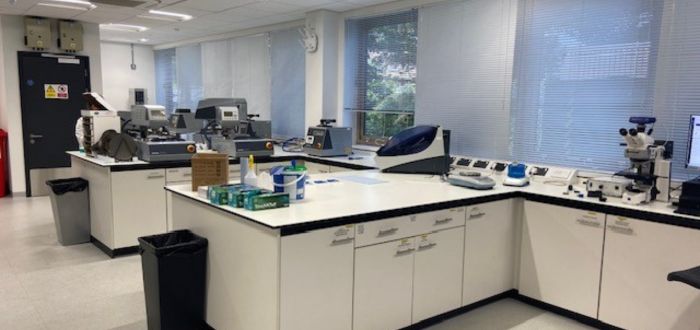Cross-sectioning and metallography
Take advantage of our cross-sectioning and metallography facilities and expertise to prepare and analyse material samples to enhance product quality, ensure reliability, and drive innovation across various industries.
The cross-sectioning, microsectioning or metallographic preparation, process involves cutting the sample down to a manageable size to fit into a mould. Resin is then introduced into the mould to encapsulate the sample. This fixes it and enables us to physically recede the mount back to the location of the area we want to look at.
Using progressively finer abrasive stages, the material from the sample is removed until we have reached the location of interest. At this point, a series of polishing stages are applied to ultimately remove all the scratches and leave us with a mirror-like finish. The sample is then ready to be examined under optical or electron microscopy.
Cross-sectioning has many applications in different areas:
- Microstructures: The exposure of a sample bulk can enable us to see the grain structure and various phases within. Features like cracking and porosity will also be visible
- Material interaction: When different materials come into contact with each other, the location of the interface between them can be checked to see if one has been dissolved in the other or if another substance, like an intermetallic or alloy layer, has been formed as a result
- Coating characterisation: A microsection at the surface of a coated material can provide a great amount of information such as the composition of the layers, substrate topography, uniformity, thickness and quality of the adhesion. Any features of particular concern like interfacial cracks or missing material can be quickly identified
- Failure analysis: Certain modes of failure are not visible on the surface and cross-sectioning can expose defects such as cracking, voiding and poor material selection
- Reverse engineering: Cross-sectioning enables us to view a product where there is no line of sight or if the features are obscured. It can help a company identify where certain components reside within a competitor’s product, for example
The university has recently commissioned a dedicated metallography laboratory in response to the increased demand for cross-sectioning work.

A broad number of industries regularly approach us for cross-sectioning to support their businesses and products.
- Automotive - e.g., failure analysis investigations looking at PCB overheating issues
- Aviation and aerospace - e.g., developing corrosion-resistant coatings in marine applications
- Military, defence & space - e.g., supporting the sector in its transition to lead-free soldering processes
- Renewables and environment - e.g., consulting in the development of coatings on photovoltaic assemblies
For more information or to discuss your cross-sectioning requirements, please contact Dr Wayne Lam at wayne.lam@brunel.ac.uk.